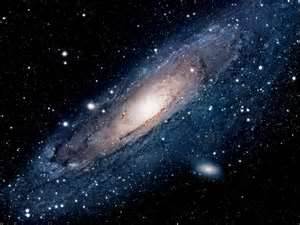The Amazing Evidence
Breaking New Evidence
Reasons to Believe (2/2021) – reports that astronomer James Green and his research team in Science Advances recently discovered that the magnetic fields of the Moon and Earth temporarily merged approximately four billion years ago (our earth and moon are calculated to have emerged about 5 to 5.5 billion years ago), forming a “coupled magnetosphere”. CLICK HERE TO CONTINUE
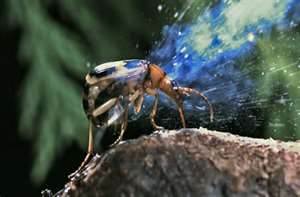
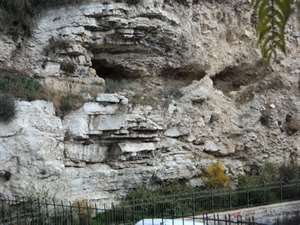
Jerusalem where Jesus was crucified

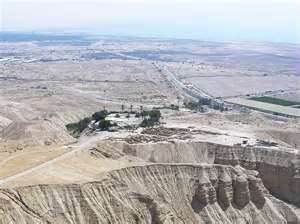

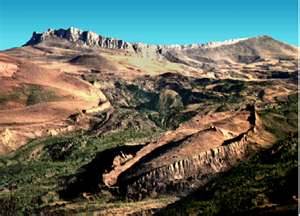
the Turkish government near Mt. Ararat, Turkey
Chapter 2
The Shroud of Turin
“So they both ran together, and the other disciple outran Peter and came to the tomb first. And he stooping down and looking in, saw the linen cloths lying there; yet he did not go in. Then Simon Peter came, following him, and went into the tomb; and he saw the linen cloths lying there, and the handkerchief that been around His head, not lying with the cloths, but folded together in a place by itself.” (John 19: 4-7)
The Shroud of Turin came to its final resting place in Italy in the year 1694. Prior to this, it was located in the chapel of Saint Chapelle, Chambery France, where it miraculously survived a fire in 1532. Although scorch marks, holes and water stains gave the impression that the Shroud was forever lost, the image upon it was by and large unblemished.1
Prior to the first scientific observations made of the Shroud in the early 1900‘s, few individuals knew of its existence. Then, in May of 1898, Italian photographer Secondo Pia was the first to take pictures of the Shroud during a special exposition. Pia was both shocked and stunned as he gazed upon the glass negative plates he was developing. Instead of a “ghostly” image that negatives usually impart, the image of the Shroud showed greater detail, definition, depth and even relief than the image upon the Shroud itself. In 1978, a team of 40 scientists gathered in Turin, Italy at the church of St. John the Baptist to research and analyze the Shroud. They conferred with 10 other investigators who were not part of the STURP (Shroud of Turin Research Project) team which had gone to St. John the Baptist, providing a total of 100,000-150,000 scientific man-hours spent on this special project.
They concluded the following about the Shroud……..
1) It is not a photograph copied on cloth, since photography did not exist at the time.
2) Electromagnetic testing for chemical compounds in the cloth came up negative, indicating that no dyes, pigments, powders or any chemical substances were used to produce the image. Therefore it is not a painted image on cloth (it’s not a painting).
3) No known chemical substances were found in or upon the cloth to support a contact phenomena whereby a chemical reaction between a human body or inanimate object (as a statue) took place. Although minute particles of blood were found in the fabric, they were totally independent of the image.
4) The image is a negative image (photographically speaking) that contains 3-dimensional imagery. There is no known mechanism for producing this type of 3-D imagery in the world, as standard photographs or paintings will always only be two dimensional.
5) The weave of the linen indicates it’s from the Middle East origin. Also, pollen found interwoven in the linen cloth revealed it came from desert varieties found exclusively in Israel.
6) Dr. Pierre Barbet’s extensive studies and experiments of crucifixion cadavers indicates that the wounds on the man of the Shroud are genuinely those of a crucifixion victim.
7) Archaeologist V. Tzaferis from the Israel Dept. of Antiquities unearthed 4 Jewish tombs and found the remains of the first “Jewish” crucifixion victim ever discovered. Analysis of these “Jewish” crucifixion victim confirmed Dr. Barbet’s research and findings as a true crucifixion.
8) The image is strickly a surface phenomena. The image went no further than 2-4 fibrils deep into the linen of the Shroud and was found to be aged or dried in an accelerated manner above the background linen.
9) The image of a crucified man on the Shroud are in total agreement with Old Testament prophecies and New Testament scriptures indicating this as an image of Jesus Christ. Nowhere has it been found to refute the scriptures regarding His crucifixion. Morever, there is no technological explanation for the mechanism that produced the image.3
The Pre-Crucifixion Wounds
The negative image produced by Secondo Pia showed such detail, that an analysis of the wounds studied by numerous medical experts indicate the man on the Shroud lines up perfectly with those wounds suffered by Jesus Christ as given in the gospel accounts of Matthew, Luke, Mark and John.
The first phase of physical violence Jesus suffered is given in Mark 14:65, “And the men who were holding Jesus in custody were mocking Him, spitting and beating Him, and they blindfolded Him saying, ‘Prophecy, who is the one who hit You?’”. On the Shroud are a collection of injuries that are in complete agreement with the scriptures of a man severely beaten on the face. We see swelling of the left cheek and side of the chin, large swelling below the right eye, torn right eyelid, swelling of both eyebrows, abraded-swollen nose. Interestingly, even the image shows signs of having His beard plucked out, a common penalty of those accused of blasphemy, as given in Matthew 26:55, “Then the high priest tore his robes, saying, ‘He has blasphemed”.
The injuries to the face no doubt were amplified after the scourging Jesus underwent as given in Mark 15:19, “…and after having Jesus scourged….they kept beating His head with a reed (staff), and spitting at Him…”
On the backside of the image, we see a man who was severely scourged (whipping/flogging). There appear numerous small marks that are dumb-belled in shape and grouped in three’s. Based on analysis, it appears two men, one taller than the other, were involved in the scourging because the blows which radiate on the right side of the body are higher than those on the left. It can also be seen that the taller man lashed excessively at the victim’s legs as the image so well shows.
The instrument used in scourging is known as the flagrum, characteristic to the Roman era. Actual specimens have been found and its design conforms to the type of wounds shown on the man on the Shroud. The flagrum is composed of three leather straps which were tipped with dumb-belled shaped pellets of lead known as plumbatea and/or bone, anchored to a wooden handle. If bone is included in its construction, the sharp pieces would cut deep into the flesh, at times exposing the bone of the flogged. Often, victims died just from the excessive blood loss and/or accumulation of pleural (chest) cavity fluids.4
Examination of the shoulder area shows a shading approximately 4“ by 3.5” on both sides of the back. This wound appears to be superimposed on the scourge marks and in all likelihood indicates that a large heavy object had abraded the skin. Again, we find that this corresponds fully with the carrying of a beam (similar to a railroad tie), weighing about 100 pounds and attached to the arms by ropes. Large contusions and abrasions to the knees of the man of the Shroud can be seen and indicates that this man fell numerous times. This would correspond to a fall that could not be broken because of the arms being tied to the beam. Scripture (John 19:17) confirms that Jesus had to carry His own cross (beam) and was later carried by Simon of Cyrene, indicating His seriously weakened condition due to the severity of the beatings and scourging. Also, the tip of the nose of the Man of the Shroud is abraded, as would occur from a fall that could not be broken.
The last characteristic of the pre-crucifixion flogging and mutilation of the man of the Shroud is so specific to Jesus, that this element of evidence should be sufficient proof to identify this man none other than Jesus Christ of Nazareth. The Man on the Shroud shows He wore a crown of thorns. Archeological and historical evidence indicates that this was not standard procedure nor part of typical crucifixions carried out in that time period. Dr. Willis’s analysis of the wound is as follows…“On the photos, we counted 8 independent streams of blood. They have been caused by puncture wounds of the scalp, which bleeds freely when injured. They have been halted on the nape of the neck which, assuming them to have been caused by something like a cap of thorns, would seem to be at a level where the thorn-branches were secured to the back of the head.”5
The Crucifixion Wounds
The uncanny similarity of wounds seen on the man on the Shroud and those described in the gospels are considered to be the burden of proof required to prove the Shroud authentic. Let us examine the medical evidence of these wounds.
The flow of blood seen on the arms of the Man on the Shroud originates from the wrists and the palms of the hand. Contrary to popular belief as depicted by numerous artists, the nail was driven into an area of the wrist known as the “Space of Destot”. This space is surrounded by strong connective tissue and ligaments that attach the hand to the forearm. Medical research has shown that if a nail is driven into the palm of the hand, the weight of the body would simply cause the nail to tear through the flesh. Also, if a nail is driven into the “Space of Destot”, it will rub up against the median nerve, one of the great nerves of the body that is responsible for controlling the hand. By the nail rubbing this nerve, it will cause the thumb to snap into the palm of the hand as a result of electrophysical stimulation. The Man on the Shroud does not show the presence of thumbs where they normally should have been, thus indicating this specific reaction and that they had been set in place by rigor mortis. Amputation of the thumbs was explicitly ruled out by medical examination. This gives great authenticity to the Shroud since no artist or forger could have known these experimentally dependent facts, for they would so have appeared on the paintings and sculptors of Christ. In fact, all Western and Byzantine art depictions of Christ’s nail wounds are medically incorrect. Only the Jesus and The Passion movies are anatomically correct in this respect.
The same is true for the nailing of the feet, where a nail was placed at the “Joint of Lisfranc”, which is between the 1st and 3rd metatarsal bones. Only this location could support the weight of a body. Any other rendering would be anatomically incorrect.
As one examines the legs of the Man on the Shroud, it can be shown medically that both legs were not broken. It was common practice for crucifixion victims to have both legs broken so they could no longer support themselves in order to breath (crucifixion victims ultimately die by suffocation because of this). This is in complete agreement with the scripture, as given in John 19:33, “But coming to Jesus, when they (the Roman soldiers) saw that He was already dead, they did not break His legs.”
Lastly, it can be seen by the man of the Shroud that He was pierced in His side by a Roman lancea. This spear, with a long leaf-like tip, corresponds exactly to the elliptical shape of the wound evidenced on the Shroud between the 5th and 6th ribs. Again, we read in John 19:34, “But one of the soldiers pierced His side with a spear, and immediately there came out blood and water.”
Directly below the wound, as seen on the Shroud, we see an effusion of water and blood. Medical research has shown that over a period of just a few hours, cellular components of blood separate out from the plasma, with the blood cells settling to the bottom. This would explain the emergence of thick cellular “bloody” flow, followed, as the level fell, by the eventual clear watery plasma fluid.”
A Photographic Phenomena
Early in 1976 Bill Motten, an image enhancement specialist, met with Dr. John Jackson of the United States Air Force (USAF). Earlier, Dr. Jackson and his colleague Dr. Eric Jumper, also of the USAF, found that there was a relationship between image intensity on the Shroud and the distance the body was separated from the cloth by micro-densitometer testing. Dr. Jackson asked Bill Motten if he might be able to use his measurements in an Interpretation Systems VP-8 Image Analyzer. The VP-8 is a device that plots shades of image brightness at levels of vertical relief to produce a three dimensional representation of objects. All the men were hopeful that this three dimensional analyzer would reveal 3D effect although they had their doubts. This works only if the image contains the three dimensional information. Yet, both had great reservations since it was common knowledge that ordinary photographs only contain two dimensional information. VP-8 analysis of two dimensional photographic images always gave obvious erroneous results by distorting and deforming the image. To the absolute amazement of both, the VP-8 analyzer produced a 3D representation of the image on the Shroud. As you could imagine, it was a spectacular and momentous occasion. They not only saw the raised features of the face, hands and feet, but also the “pigtail” of hair that was fashionable among Jews of Jesus’ day. The “owlish” eyes that previously defied description now had an unnatural bulge to them. Dr. Jumper read in the “Jewish Quarterly Review” of 1898 that it was customary to lay coins or pieces of potsherd over the eyes of the deceased. This was done with the intention of preventing the deceased from “seeing” the way by which he was carried to his last home, the tomb. It was later determined that a small coin placed on each closed eye would best match the 3D configuration. Most important, the three dimensional representation proved beyond a reasonable doubt that the image of the man on the Shroud was not produced by human craft. Yet, a standard 2-D photograph taken of the man of the Shroud can also confer three dimensions when passed through an image analyzer such as the VP-8. This is absolutely miraculous! It has been found that nowhere in the world does there exist a shroud, painting, picture or any other reproduction that can assimilate three dimensional information into a photograph except the Shroud of Turin. Any reproduction by human means, whether it be a painting or any other type of rendering, always produces a two-dimensional image. So, we find that the Shroud is a three dimensional image that has never been duplicated to this day and is the only one known to exist throughout the whole world.
Circumstantial Conclusion
Early in the year of 1900 a group of scientists, lead by French biologist Paul Vignon, gathered at the famous Sorbonne Institute in Paris to study Pia Secundo’s photographs. It was their goal, as it was STURP’s, to anatomically validate or repudiate the man and “his” wounds on the Shroud as that of Jesus Christ of Nazareth. One of the noted scientists of the group was Dr. Yves Delage, professor of comparative anatomy at the Sorbonne. Dr. Delage was well known for his agnosticism and rejection of the supernatural. On April 21, 1902 he presented his review of the Shroud in a paper titled, “The Image of Christ Visible on the Holy Shroud of Turin”. He concluded that the image on the Shroud was of Christ, created by a special physiochemical process while He had lain in the tomb. Dr. Delage pointed out that from a medical point of view, the wounds and all other data were so anatomically flawless, that it seemed impossible that it could be the work of an artist, much less a forger. He was severely criticized for his finding. Here is an excerpt of his letter to the “Revue Scientifique”, a leading scientific journal of its day, regarding his conclusion of the image on the Shroud……
“I have been faithful to the true spirit of science in treating this question, intent only on the truth, not concerned in the least whether it would affect the interests of any religious party…I recognize Christ as a historical parsonage and I see no reason why anyone should be scandalized that there still exist natural traces of His earthly life…If, instead of Christ, there were question of some person like a Sargon, an Achilles or one of the Pharaohs, no one would have thought of making any objection.”
If Dr. Delage could come to such a conclusion based on scientific research, then what is stopping you from doing the same? This becomes even more pronounced as incredible new evidence continues to pour in about the truth of God and His Son, Jesus. Jesus, who is God in the flesh, came to earth to give all humanity an opportunity to receive eternal life. Jesus suffered on the cross for both you and me. I pray you realize the great love He has for you to have done this. All you need to do is receive Him
What About the Other Linen Wrappings?
In a typical Jewish burial process, the first task to be performed would be to wash the body, a practice common to most cultures. Then the body would be covered with the spices of aloe and myrrh, acting as antiputrefacients that inhibit the decaying process). Thereafter, the body would be buried with white garments typically only worn during holy festivals. Lastly, the feet and wrists would be bound with linen bands known as “orthonia” (Greek word meaning linen bands) and the chin with a linen band called the “soudarin”. These were used to prevent the legs, arms and mouth from assuming unacceptable positions because of rigor mortis. Therefore, the multiple linen wrappings that were seen folded separately are accounted for in the Gospels which helps to validate the Shroud as the total body/head covering.8
Early on Sunday morning, while it was still dark, Mary Magdalene came to the tomb and found that the stone had been rolled away from the entrance. She ran and found Simon Peter and the other disciple (referring to John), the one whom Jesus loved. She said, They have taken the Lord’s body out of the tomb, and we don’t know where they have put Him. Peter and the other disciple (again refering to John) started out for the tomb. They were both running, but the other disciple outran Peter and reached the tomb first. He stooped and looked in and saw the linen wrappings lying there, while the cloth that that had covered Jesus’ head was folded up and lying apart from the other wrappings. (John 20:1-7) NEXT CHAPTER
Helping Our Mission
Although this web book is free of charge, we ask that if you are impacted by this work and its been a blessing to you, to consider offering a donation of any amount to help with our work and mission.
We believe a fair donation for this book is $10. However, we would be so blessed with any amount that the Lord places on your heart.
To give, just go to our DONATIONS LINK above . Thank You!
The text boxes below contain additional commentary or scripture references to the main body of the book. Other times they explain elements described in the main body of the book in greater detail for greater understanding and comprehension. However, it is not essential that they be read.
Numbers following the text are footnote designations and can be looked up in our Bibliography and Footnote section.
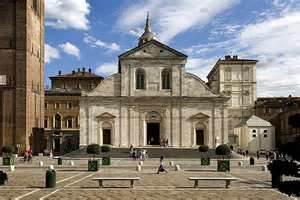
Cathedral of St. John the Baptist in Turin, Italy where the Shroud is held.

Enclosure where the Shroud is held at the church of St. John the Baptist
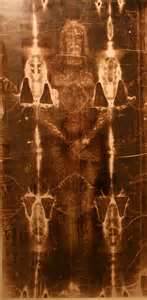
The picture you see above was taken by the Shroud of Turin Research Project (STURP) in 1978. It is the most up-to-date photo taken and it’s clarity and detail is unrivaled.
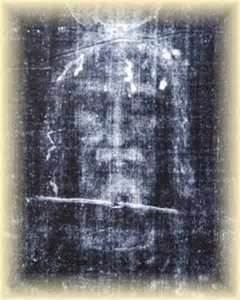
Original negative photo taken by Secondo Pia. Notice rivlets of blood from top of head.
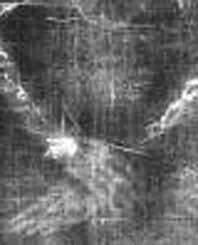
The Space of Destot is shown in the Shroud photo with the spike going through the wrist, which was classified as the upper hand.
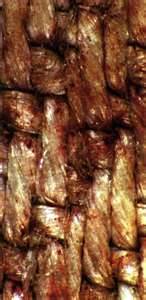
Magnification of the linen weave of the Shroud showing verified blood particles.
Lead STURP Assessment
The team expected the Shroud to be in a delicate condition. This is expected, since linen cannot survive well in termperate climates, such a France and Italy. This is especially true to high humidity levels where oxidation, fungi, bacteria, etc. would cause it to decay. Yet the linen was supple, strong and felt like new. We have no explanation for this.6 (Dr. J. Heller – STURP)

Three dimensional image of the Shroud picture
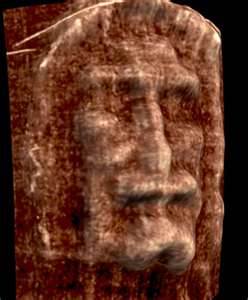
Enlargement of a facial 3-D analysis performed on the Shroud by the VP-8. A picture of The Shroud is the only artifact that provides 3-D information based on two dimensional photography.
Lead STURP Assessment
“Many of us were at first quite confident of our technical adequacy. Some may have even been cocky. But none of us survived this extraordinary voyage into the unknown without becoming more humble and more aware of the dimensions of our ignorance.”7 (Dr. J. Heller – STURP)
